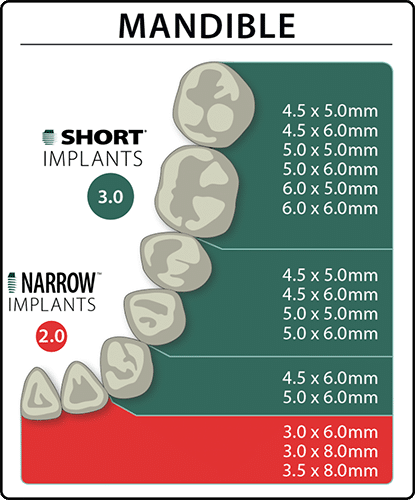BICON DENTAL IMPLANTSBY INDICATION
OVERVIEW
IMPLANT SIZE RECOMMENDATIONS:
The charts below contain recommended implant sizes only. Actual clinical conditions and the clinician’s assessment of the patient should be the main criteria for choosing the size of an implant for a particular area. In general, it is better to use a 5.0mm SHORT® Implant than a longer length so that the implant may be positioned 2.0 to 3.0mm below the alveolar crest. The width of the alveolar bone may be assessed with a CBCT scan, periodontal probe, or caliper. It is advisable to have 1.0mm of bone surrounding an implant for a long-term favorable prognosis.
Maxillary Anterior and Posterior Implants
NOTE: 2.5mm well implants have been designed exclusively for maxillary anterior single-unit restorations. For any other restoration, including maxillary anterior splinted prostheses, overdentures, or fixed-removable applications, it is strongly recommended to avoid 2.5mm well implants.
In posterior sites, the 2.5mm post abutments may be too retentive and not easily removed.
For maxillary anterior implants, anticipate the need for bone grafting or ridge splitting techniques.

Mandible Anterior and Posterior Implants
NOTE: The 3.0 and 3.5mm diameter implants are generally for mandibular anterior teeth. If practical, their use should be avoided for maxillary anterior and all posterior teeth.
It is advisable to have at least 1.0mm of bone around the implant. Therefore, an advisable bone width of 5.5mm is necessary to comfortably accommodate a 3.5mm implant, unless ridge splitting or grafting techniques are employed to widen the site.
GENERAL IMPLANT INFORMATION
- All implants are packaged with a healing plug.
- The choice of implant length and width depends upon available bone and expected occlusal loads.
- For an aesthetic emergence profile, the Bicon implant is designed to be placed below the crest of the alveolar ridge to the extent that the implant is 5.0mm below the facial crest of the gingiva.
- The implant may be placed at or slightly above the alveolar crest, if an aesthetic emergence profile is not a concern.
- In general, choose the widest but not necessarily the longest implant the bone will allow.
- 2.5mm well implants have been designed exclusively for maxillary anterior single-unit restorations. For any other restoration, including maxillary anterior splinted prostheses, overdentures, or fixed-removable applications, it is strongly recommended to avoid 2.5mm well Implants.
- Posteriorly to the canine, place one implant per tooth if practical.
- See Reference for depth indicators on the 2.0mm Pilot Drill and the Latch Reamers.